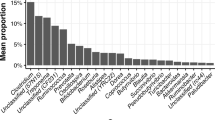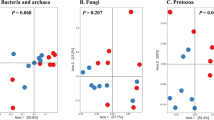Abstract
We aimed to study how seasonal heat stress (i.e., spring vs. summer) influenced microbiota diversity in the dairy cows’ feces using Illumina MiSeq sequencing. Sixteen dairy cows were experiencing spring thermoneutral conditions (daily mean temperature = 18.8 ± 3.40 °; daily mean THI = 64.29 ± 4.94) and 16 under summer heat stress (daily mean temperature = 27.63 ± 5.34 °; daily mean THI = 82.56 ± 1.74). Fecal samples were collected per cow three times daily from day 18 to day 22 during each experimental period. Results revealed that the microbiota diversity in the feces was significantly lower (P < 0.05) under summer heat stress. At both the phylum and genera levels, significant differences were observed on microbiota composition in cow’s feces between spring and summer. The most dominant phylum was Firmicutes, contributing 69.45% and 87.14% of the fecal microbiota in spring and summer, respectively, followed by Bacteroidetes, contributing 25.27% and 4.45%, respectively. Compared with the dairy cows in the spring season, the relative abundance of unclassified Peptostreptococcaceae, Turicibacter, and Clostridium_sensu_stricto_1 (P < 0.05) were greatly increased (P < 0.05), while the significant decrease in the proportion of Ruminococcaceae_UCG-005 and Rikenellaceae_RC9_gut_group as well as Bacteroides were observed in hot summer. Prediction of microbiota gene function in feces based on PICRUSt method found that different microbiota between spring and summer were mainly concentrated on the function related to membrane transport, infectious diseases, immune system diseases, and lipid metabolism. This study demonstrates that diversity and composition of fecal microbiota in dairy cows varies under different THI condition, and the relationship between fecal microbiota and cows’ health needs further research.





Similar content being viewed by others
References
Ahmad G, Agarwal A, Esteves S, Sharma R, Almasry M, Al-Gonaim A, AlHayaza G, Singh N, Al Kattan L, Sannaa W, Sabanegh E (2017) Ascorbic acid reduces redox potential in human spermatozoa subjected to heat-induced oxidative stress. Andrologia 49(10):e12773. https://doi.org/10.1111/and.12773
Arumugam M, Raes J, Pelletier E, Paslier DL, Yamada T, Mende DR, Fernandes GR, Tap J, Bruls T, Batto JM (2011) Enterotypes of the human gut microbiome. Nature 473:174–180. https://doi.org/10.1038/nature09944
Bishop-Williams KE, Berke O, Pearl DL, Hand K, Kelton DF (2015) Heat stress related dairy cow mortality during heat waves and control periods in rural Southern Ontario from 2010–2012. BMC Vet Res 11(1):291. https://doi.org/10.1186/s12917-015-0607-2
Buffington D, Collazo-Arocho A, Canton G, Pitt D, Thatcher W, Collier R (1981) Black globe-humidity index (BGHI) as comfort equation for dairy cows. Trans ASAE 24(3):711–714
Calamari L, Morera P, Bani P, Minuti A, Basiricò L, Vitali A, Bernabucci U (2018) Effect of hot season on blood parameters, fecal fermentative parameters, and occurrence of Clostridium tyrobutyricum spores in feces of lactating dairy cows. J Dairy Sci 101(5):4437–4447. https://doi.org/10.3168/jds.2017-13693
Caporaso JG, Lauber CL, Walters WA, Berg-Lyons D, Huntley J, Fierer N, Owens SM, Betley J, Fraser L, Bauer M (2012) Ultra-high-throughput microbial community analysis on the Illumina HiSeq and MiSeq platforms. ISME J 6(8):1621–1624. https://doi.org/10.1038/ismej.2012.8
Erickson AR, Cantarel BL, Lamendella R, Darzi Y, Mongodin EF, Pan C, Shah M, Halfvarson J, Tysk C, Henrissat B (2012) Integrated metagenomics/metaproteomics reveals human host-microbiota signatures of Crohn’s disease. PLoS One 7(11):e49138. https://doi.org/10.1371/journal.pone.0049138
Fecteau M-E, Pitta DW, Vecchiarelli B, Indugu N, Kumar S, Gallagher SC, Fyock TL, Sweeney RW (2016) Dysbiosis of the fecal microbiota in cattle infected with Mycobacterium avium subsp. paratuberculosis. PLoS One 11:e0160353. https://doi.org/10.1371/journal.pone.0160353
Garcia JP, Adams V, Beingesser J, Hughes ML, Poon R, Lyras D, Hill A, Mcclane BA, Rood JI, Uzal FA (2013) Epsilon toxin is essential for the virulence of Clostridium perfringens type D infection in sheep, goats, and mice. Infect Immun 81(7):2405–2414. https://doi.org/10.1128/IAI.00238-13
Gonzalez-Rivas PA, Sullivan M, Cottrell JJ, Leury BJ, Gaughan JB, Dunshea FR (2018) Effect of feeding slowly fermentable grains on productive variables and amelioration of heat stress in lactating dairy cows in a sub-tropical summer. Trop Anim Health Prod 50(8):1763–1769. https://doi.org/10.1007/s11250-018-1616-5
Habashy WS, Milfort MC, Adomako K, Attia YA, Rekaya R, Aggrey SE (2017) Effect of heat stress on amino acid digestibility and transporters in meat-type chickens. Poult Sci 96(7):2312–2319. https://doi.org/10.3382/ps/pex027
Hagey JV, Bhatnagar S, Heguy JM, Karle BM, Price PL, Meyer D, Maga EA (2019) Fecal microbial communities in a large representative cohort of California dairy cows. Front Microbiol 10:1093. https://doi.org/10.3389/fmicb.2019.01093
Henderson G, Cox F, Ganesh S, Jonker A, Young W, Collaborators GRC, Abecia L, Angarita E, Aravena P, Arenas GN (2015) Rumen microbial community composition varies with diet and host, but a core microbiome is found across a wide geographical range. Sci Rep 5(1):14567. https://doi.org/10.1038/srep19175
Jiao J, Li X, Beauchemin KA, Tan Z, Tang S, Zhou C (2015) Rumen development process in goats as affected by supplemental feeding v. grazing: age-related anatomic development, functional achievement and microbial colonisation. Br J Nutr 113(6):888–900. https://doi.org/10.1017/S0007114514004413
Jin W, Wang Y, Li Y, Cheng Y, Zhu W (2018) Temporal changes of the bacterial community colonizing wheat straw in the cow rumen. Anaerobe 50:1–8. https://doi.org/10.1016/j.anaerobe.2018.01.004
Kellermayer R, Dowd SE, Harris RA, Balasa A, Schaible TD, Wolcott RD, Tatevian N, Szigeti R, Li Z, Versalovic J (2011) Colonic mucosal DNA methylation, immune response, and microbiome patterns in Toll-like receptor 2-knockout mice. FASEB J 25(5):1449–1460. https://doi.org/10.1096/fj.10-172205
Khafipour E, Li S, Plaizier JC, Krause DO (2009) Rumen microbiome composition determined using two nutritional models of subacute ruminal acidosis. J Appl Environ Microbiol 75(22):7115–7124. https://doi.org/10.1128/AEM.00739-09
Kim M, Morrison M, Yu Z (2011) Phylogenetic diversity of bacterial communities in bovine rumen as affected by diets and microenvironments. Folia Microbiol 56(5):453. https://doi.org/10.1007/s12223-011-0066-5
Kim M, Morrison M, Yu Z (2015) Status of the phylogenetic diversity census of ruminal microbiomes. FEMS Microbiol Ecol 76(1):49–63. https://doi.org/10.1111/j.1574-6941.2010.01029.x
Lee JE, Lee S, Sung J, Ko G (2011) Analysis of human and animal fecal microbiota for microbial source tracking. ISME J 5(2):362. https://doi.org/10.1038/ismej.2010.120
Ley RE, Turnbaugh PJ, Samuel K, Gordon JI (2006) Microbial ecology: human gut microbes associated with obesity. Nature 444(7122):1022–1023. https://doi.org/10.1038/4441022a
Liu Z, DeSantis TZ, Andersen GL, Knight R (2008) Accurate taxonomy assignments from 16S rRNA sequences produced by highly parallel pyrosequencers. Nucleic Acids Res 36(18):e120. https://doi.org/10.1093/nar/gkn491
Lu K, Abo RP, Schlieper KA, Graffam ME, Levine S, Wishnok JS, Swenberg JA, Tannenbaum SR, Fox JG (2014) Arsenic exposure perturbs the gut microbiome and its metabolic profile in mice: an integrated metagenomics and metabolomics analysis. Environ Health Perspect 122(3):284–291. https://doi.org/10.1289/ehp.1307429
Mao S, Zhang R, Wang D, Zhu W (2012) The diversity of the fecal bacterial community and its relationship with the concentration of volatile fatty acids in the feces during subacute rumen acidosis in dairy cows. BMC Vet Res 8(1):237. https://doi.org/10.1186/1746-6148-8-237
Mao S, Zhang M, Liu J, Zhu W (2015) Characterising the bacterial microbiota across the gastrointestinal tracts of dairy cattle: membership and potential function. Sci Rep 5:16116. https://doi.org/10.1038/srep16116
Meale SJ, Li S, Azevedo P, Derakhshani H, Plaizier JC, Khafipour E, Steele MA (2016) Development of ruminal and fecal microbiomes are affected by weaning but not weaning strategy in dairy calves. Front Microbiol 7:e84033. https://doi.org/10.3389/fmicb.2016.00582
Milani C, Ticinesi A, Gerritsen J, Nouvenne A, Lugli GA, Mancabelli L, Turroni F, Duranti S, Mangifesta M, Viappiani A (2016) Gut microbiota composition and Clostridium difficile infection in hospitalized elderly individuals: a metagenomic study. Sci Rep 6:25945. https://doi.org/10.1038/srep25945
Pandey P, Hooda O, Kumar S (2017) Impact of heat stress and hypercapnia on physiological, hematological, and behavioral profile of Tharparkar and Karan Fries heifers. Vet World 10(9):1146–1155. https://doi.org/10.14202/vetworld.2017.1146-1155
Patra AK, Yu Z (2015) Essential oils affect populations of some rumen bacteria in vitro as revealed by microarray (RumenBactArray) analysis. Front Microbiol 6:297. https://doi.org/10.3389/fmicb.2015.00297
Plaizier JC, Li S, Danscher AM, Derakshani H, Andersen PH, Khafipour E (2017) Changes in microbiota in rumen digesta and feces due to a grain-based subacute ruminal acidosis (SARA) challenge. Microb Ecol 74(2):485–495. https://doi.org/10.1007/s00248-017-0940-z
Schloss PD, Westcott SL, Ryabin T, Hall JR, Hartmann M, Hollister EB, Lesniewski RA, Oakley BB, Parks DH, Robinson CJ, Sahl JW, Stres B, Thalliger GG, Van Horn DJ, Weber CF (2009) Introducing mothur: open-source, platform-independent, community-supported software for describing and comparing microbial communities. Appl Environ Microbiol 75(23):7537–7541. https://doi.org/10.1128/AEM.01541-09
Tajima K, Nonaka I, Higuchi K, Takusari N, Kurihara M, Takenaka A, Mitsumori M, Kajikawa H, Aminov RI (2007) Influence of high temperature and humidity on rumen bacterial diversity in Holstein heifers. Anaerobe 13(2):57–64. https://doi.org/10.1016/j.anaerobe.2006.12.001
Turnbaugh PJ, Ley RE, Mahowald MA, Magrini V, Mardis ER, Gordon JI (2006) An obesity-associated gut microbiome with increased capacity for energy harvest. Nature 444(7122):1027–1031. https://doi.org/10.1038/nature05414
Uyeno Y, Sekiguchi Y, Tajima K, Takenaka A, Kurihara M, Kamagata Y (2010) An rRNA-based analysis for evaluating the effect of heat stress on the rumen microbial composition of Holstein heifers. Anaerobe 16(1):27–33. https://doi.org/10.1016/j.anaerobe.2009.04.006
Vitali A, Segnalini M, Bertocchi L, Bernabucci U, Nardone A, Lacetera N (2009) Seasonal pattern of mortality and relationships between mortality and temperature-humidity index in dairy cows. J Dairy Sci 92(8):3781–3790. https://doi.org/10.3168/jds.2009-2127
Wang T, Cai G, Qiu Y, Fei N, Zhang M, Pang X, Jia W, Cai S, Zhao L (2012) Structural segregation of gut microbiota between colorectal cancer patients and healthy volunteers. ISME J 6(2):320–329. https://doi.org/10.1038/ismej.2011.109
Wang Y, Xu L, Liu J, Zhu W, Mao S (2017) A high grain diet dynamically shifted the composition of mucosa-associated microbiota and induced mucosal injuries in the colon of sheep. Front Microbiol 8:2080. https://doi.org/10.3389/fmicb.2017.02080
Wu H, Nguyen QD, Tran TT, Tang MT, Tsuruta T, Nishino N (2019) Rumen fluid, feces, milk, water, feed, airborne dust, and bedding microbiota in dairy farms managed by automatic milking systems. Anim Sci J 90:445–452. https://doi.org/10.1111/asj.13175
Yazdi MH, Mirzaei-Alamouti H, Amanlou H, Mahjoubi E, Nabipour A, Aghaziarati N, Baumgard L (2016) Effects of heat stress on metabolism, digestibility, and rumen epithelial characteristics in growing Holstein calves. J Anim Sci 94(1):77–89. https://doi.org/10.2527/jas.2015-9364
Zhang Y, Wu R, Zhang Y, Wang G, Li K (2018) Impact of nutrient addition on diversity and fate of fecal bacteria. Sci Total Environ 636:717–726. https://doi.org/10.1016/j.scitotenv.2018.04.312
Zhu Z, Kristensen L, Difford GF, Poulsen M, Noel SJ, Al-Soud WA, Sørensen SJ, Lassen J, Løvendahl P, Højberg O (2018) Changes in rumen bacterial and archaeal communities over the transition period in primiparous Holstein dairy cows. J Dairy Sci 101(11):9847–9862. https://doi.org/10.3168/jds.2017-14366
Funding
This work was supported by the Chinese Key Research and Development Program (2016YFD0500507 and 2018YFD0501605), Fundamental Research Funds for the Central Universities (2662018Y079), and Open Project of Wuhan Academy of Agricultural Sciences (Kfxkt201805).
Author information
Authors and Affiliations
Corresponding author
Ethics declarations
Conflicts of interest
The authors declare that they have no conflict of interest.
Ethical approval
The protocol for this experiment was approved by the Institution Animal Care and Use Committee at Huazhong Agriculture University (Wuhan, China), and the animal trial was conducted in accordance with the National Institute of Health Guidelines for the Care and Use of Experiment Animals (Beijing, China).
Additional information
Publisher’s note
Springer Nature remains neutral with regard tojurisdictional claims in published maps and institutional affiliations.
Electronic supplementary material
ESM 1
(PDF 365 kb)
Rights and permissions
About this article
Cite this article
Li, H., Li, R., Chen, H. et al. Effect of different seasons (spring vs summer) on the microbiota diversity in the feces of dairy cows. Int J Biometeorol 64, 345–354 (2020). https://doi.org/10.1007/s00484-019-01812-z
Received:
Revised:
Accepted:
Published:
Issue Date:
DOI: https://doi.org/10.1007/s00484-019-01812-z




